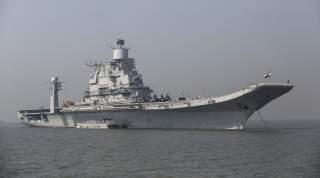India's Aircraft Carrier Caught On Fire. China Thinks It Knows Why.
Ridiculous?
The blaze was extinguished, but not before an Indian Navy lieutenant commander, who led the firefighting effort, was overcome by fumes and later died in hospital, according to Indian media. He had gotten married just a month earlier.
India’s only aircraft carrier suffered a fire that left one sailor dead.
And China, which is India’s rival, says this is because Indians aren’t competent enough to operate advanced military equipment.
(This appeared first earlier May 2019.)
The fire broke out in the engine room of the carrier Vikramaditya as it entered the Indian naval base at Karwar on April 26.
The blaze was extinguished, but not before an Indian Navy lieutenant commander, who led the firefighting effort, was overcome by fumes and later died in hospital, according to Indian media. He had gotten married just a month earlier.
The Indian Navy reported that the fire had not seriously damaged the combat capabilities of the vessel, which is India’s only operational carrier. The 45,000-ton Vikramaditya – the ex-Soviet carrier Admiral Gorshkov -- had just completed a deployment in the Arabian Sea, and was preparing to begin joint exercises with the French Navy’s only aircraft carrier, the Charles de Gaulle, off the Indian coast.
The cause of the fire has not yet been disclosed. But Chinese media quickly ran a story that suggested the fire was the result of Indian incompetence. Li Jie, a Chinese naval expert, told the state-owned Global Times newspaper “that the fire was more likely to be out of human error rather than mechanical problems. The fire and the extinguishing process suggested that they are unprofessional and unprepared to address such an emergency, he said.”
“India has been actively developing its military in recent years, but ‘its military culture is lax and it has loose regulations,’ which cannot effectively train soldiers to operate advanced military equipment, Li said.”
That criticism comes despite that fact that India has far more experience than China in operating aircraft carriers. India’s first carrier, the Vikrant, a former World War II British carrier, was commissioned in 1961. It performed combat duty in the 1971 India-Pakistan War. China’s first carrier, the Liaoning – the ex-Soviet carrier Varyag – wasn’t commissioned until 2012. It has yet to see action.
Ironically, both India and China are in the midst of ramping up their carrier fleets. India is completing a new Vikrant, which will be the nation’s first domestically-produced carrier. It has also announced plans to build a 65,000-ton carrier, which might even be based on the Royal Navy’s Queen Elizabeth-class vessels.
China’s first indigenous-produced carrier, a Type 001A vessel, is scheduled to be launched in late 2019. Beijing appears to have far grander ambitions than India, with reports indicating that the People’s Liberation Army Navy may get as many as six new carriers by 2035.
China’s contempt for Indian technical competence also seems misplaced. In 2003, all 70 sailors aboard the Chinese diesel submarine 361 died, probably because an engine malfunction suffocated them. China’s first nuclear-powered missile submarine was so bad that it only sailed once.
In fact, during the Cold War, it was China that relied on huge armies of infantry armed with old Soviet-designed weapons. India was able to use mechanized forces to win wars against Pakistan in 1965 and 1971. Shocked by the lethality of American smart weapons during the 1991 Persian Gulf War, China has since embraced high-tech warfare, from stealth fighters to hypersonic missiles, with all the zeal of a convert.
The Indian military certainly deserves its share of criticism. It has suffered numerous accidents over the past decade, including a corvette that sank after a collision with a merchant vessel in 2006. Development of new weapons, such as the Arjun tank and the Tejas fighter, has become notorious for delays, cost overruns and technical problems.
But it’s not as if America and Russia haven’t had plenty of naval disasters (the USS Fitzgerald and the submarine Kursk, anyone?), or spent billions on failed weapons. Accidents happen when warships go to sea. Sometimes for the dumbest of reasons, but they happen.
China and India are rivals. And underestimating your enemy is always a mistake.
Michael Peck is a contributing writer for the National Interest. He can be found on Twitter and Facebook.

